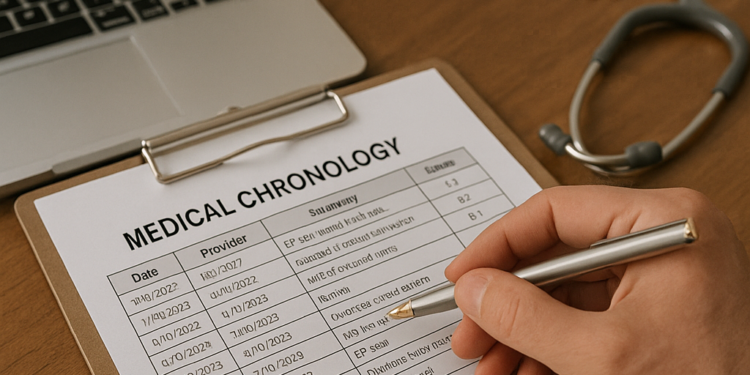Why Medical Chronologies Matter in Legal Case Reviews

Legal cases involving personal injury, insurance claims, or medical malpractice frequently present numerous challenges, especially when the patient’s medical journey spans multiple providers, specialists, and healthcare facilities. Attorneys and legal professionals must sift through extensive records that can run into hundreds or thousands of pages. Essential details are often buried in this paperwork, making creating a straightforward narrative or timeline of events challenging. Without an organized system, crucial facts may go unnoticed, leading to incomplete analysis and potentially weaker legal arguments.
Medical chronologies from Tavrn address this problem by offering meticulously constructed, AI-powered summaries that distill raw, often repetitive data into a coherent, linear format. These solutions allow legal teams to move from overwhelming chaos to clarity, offering a shortcut to the information that matters most for case development. With a well-organized chronology, legal professionals can quickly highlight the sequence of medical encounters, uncover injury patterns, and identify moments pivotal to the claim or defense.
These chronologies play a vital role in situations such as untangling the aftermath of a car accident, understanding multiple hospitalizations following a workplace injury, or investigating whether a delayed diagnosis contributed to long-term complications. Having an accessible, detailed summary of a patient’s medical events ensures attorneys never overlook a treatment, appointment, or symptom that could influence the outcome. Moreover, a digital-first approach to compiling and formatting these documents helps make preparation more efficient, slashes the risk of errors caused by oversight, and translates directly into time savings for busy legal professionals.
As legal casework has grown in sophistication and complexity, attorneys now face higher demands for accuracy, speed, and thorough documentation. Dependable medical chronologies—especially those created by digital platforms with advanced features—have become indispensable resources for any legal team aiming to maintain a competitive edge in high-stakes legal reviews.
Table of Contents
Understanding Medical Chronologies
A medical chronology is, at its core, a systematic timeline that organizes and presents a patient’s health information in a clear, sequential format. It methodically arranges every key element of the medical record: dates of visits, summaries of diagnoses, lists of medications, surgical procedures, imaging reports, lab results, and follow-up appointments. The goal is to transform a sprawling, unstructured archive of data into an intelligible, logical narrative that enables lawyers and experts to see the complete picture of the client’s history in a glance.
Without this order, vital facts can disappear amid a sea of handwritten notes, varying provider formats, and inconsistent terminology. A skillful chronology serves as a concise reference guide that streamlines the review process for everyone involved in the litigation, from paralegals and attorneys to medical experts and, ultimately, juries. This organization reduces wasted time searching for key details, boosts accuracy, and ensures that legal arguments rest on a well-founded account of events.

The Role of Medical Chronologies in Legal Cases
Establishing causality is crucial in personal injury litigation, insurance matters, or medical malpractice lawsuits. A medical chronology helps attorneys draw connections between the inciting incident and the progression of symptoms, medical evaluations, and treatments. This organized timeline enables legal teams to construct a logical argument that can withstand scrutiny from opposing counsel, expert reviewers, and judges.
Quantifying damages requires a detailed understanding of the client’s medical care’s duration, intensity, and impact. Medical chronologies aid in mapping every relevant healthcare appointment, examination, therapy session, medical device, and prescription medication, supporting the attorney’s assertion of financial and non-financial losses. This promotes fairness and objectivity when negotiating settlements or arguing before a jury.
Streamlining case preparation requires efficient access to the facts. Traditional reviews of unorganized medical records are time-consuming and costly, hindering legal teams from focusing on strategy and advocacy. Medical chronologies condense scattered medical data into a logical reference tool that highlights patterns of care, critical turning points, red flags, and potential evidence gaps. Legal professionals can increase their productivity and elevate the quality of pretrial planning by improving workflow and allowing faster orientation to case facts.
Benefits of Utilizing Medical Chronologies
Medical chronologies are crucial in legal cases as they enhance communication and facilitate the understanding of health information. They help convert complex technical notes into plain language, fostering shared understanding and decision-making. They also support expert testimony by allowing medical professionals to review a client’s history and draw informed conclusions about the standard of care, causation, and prognosis. Legal teams that provide well-designed chronologies empower experts to provide consistent, authoritative testimony, enhancing credibility and clarity.
A well-crafted chronology also helps identify gaps and inconsistencies in medical records, which can undermine a legal case if left unnoticed. By exposing these gaps early, attorneys can proactively request missing documents, follow up with providers, or clarify ambiguous details. This diligence reduces the risk of surprise challenges from opposing counsel and fortifies the case against attacks on its accuracy or integrity. Overall, medical chronologies play a vital role in legal cases.
Creating Effective Medical Chronologies
Crafting a useful medical chronology is a technical and practical exercise that demands precision and impartiality. The most effective chronologies demonstrate:
- Accuracy: Every event, annotation, and detail must reflect the actual content of the medical record without embellishment, omission, or transcription error.
- Objectivity: All entries are presented as factual accounts, with no room for inference or bias—only what is documented in the records.
- Comprehensiveness: A complete chronology traces the entirety of relevant care, from initial evaluations to the conclusion of treatment or ongoing management, ensuring no key encounter is overlooked.
- Clarity: The use of straightforward language, organized tables, and logical structure assures accessibility to every stakeholder, regardless of their familiarity with medical terms.
Leveraging advanced platforms allows legal professionals to create robust and consistent chronologies, lessening their dependency on laborious manual compilation and offering greater confidence in the product’s integrity. These innovations permit easy updates, rapid sharing, and collaboration among the legal team or outside experts.
Conclusion
Medical chronologies have become a cornerstone of modern legal case reviews, particularly where health records and legal standards determine the case’s success. By offering structure, clarity, and objective detail through expertly compiled timelines, attorneys can more effectively analyze evidence, present their findings, and, most importantly, advocate for the best interests of their clients. With solutions like Tavrn’s MedChrons, legal teams gain access to tools that shorten the review process and enhance the precision and reliability of case preparation—raising the bar for legal-medical collaboration now and in the future.






